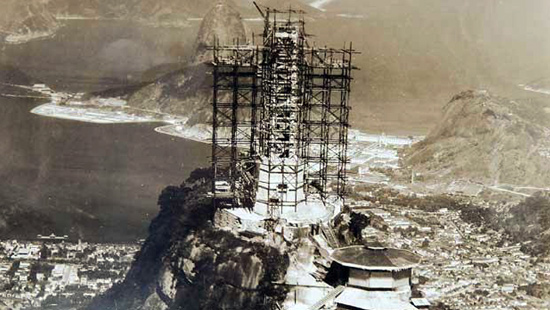Who has never been charmed by a photo of Christ the Redeemer, with its open arms watching The Marvelous City from the top of Corcovado? Elected one of the Seven Wonders of the Modern World, in an open survey released in July 2007, Christ the Redeemer is the largest Art Deco statue in the world. It is 38 meters (124ft) high and its arms have 88 square meters area (947 ft²) each.
Although it is one of the most known and visited tourist attractions in Rio de Janeiro and Brazil, few people know Christ the Redeemer’s history and how this huge and imposing statue was designed. For this reason, Rede Rio decided to write this entire article about the history of this monument. It’s no wonder why it is considered one of the most beautiful and important monuments in the world. Check it out!
Christ the Redeemer’s History
Where did the idea come from?
The first time it occurred to anyone to build a giant religious monument on the top of Corcovado in Rio de Janeiro was in 1859, when the French Lazarist Father Pierre-Marie Boss considered this idea. He even recorded his desire in a book, called “Imitação de Cristo” (“Imitation of Christ”), published in 1903:
“O Corcovado!…
Lá se ergue o gigante de pedra, alcantilado, altaneiro e triste,
como interrogando o horizonte imenso – Quando virá?
Há tantos séculos espero! Sim, aqui está o Pedestal único no mundo.
Quando vem a estátua, como eu, colossal imagem de Quem me fez?”
The priest’s desire only began to become reality in the preparations for the centennial of Independence, celebrated in 1922. A dispute to choose a project for the monument was set and Heitor da Silva Costa was the winner. The idea was to build the statue of Christ the Redeemer only with donations from Brazilians. Several collection campaigns were carried out and a petition was sent to President Epitácio Pessoa so the construction could be authorized. In all, the construction costed approximately 2500 contos de réis, which is equivalent to 9.5 million Brazilian reais, coming from donations of people from all over the country.
How the project was put into action?

The project was a joint work of the designer Heitor da Silva Costa, the painter Carlos Oswald and the sculptor Maximilian Paul Landowski. Christ the Redeemer is an Art Deco-style sculpture, with open arms in a cross shape, 38 meters (124ft) high which equivalents to a 13-storey building. Of this amount, 30 meters (98ft) corresponds to the monument and the other 8 meters (26ft) corresponds to the pedestal. Each arm occupies an area of 88 square meters (947 ft²) and the foot measures 1.35 meters (4ft). The total weight of the statue is approximately 1145 tons, of which 30 tons correspond only the head.
Hands and head are the only parts of Christ the Redeemer that weren’t built in Brazil. They were shaped in Paris. The statue’s body is made entirely of soapstone, cut into triangles, glued by hand in a fabric and applied in the structure made of reinforced concrete. The monument is made to withstand winds of up to 250 km per hour.
The construction lasted nine years, from 1922 to 1931, and was inaugurated on October 12, 1931, during the festivities of Nossa Senhora Aparecida.
How Christ the Redeemer was elected one of the Wonders of the Modern World?
The Seven Wonders of the Modern World were elected through an informal vote, idealized by a Swiss organization, based on criteria such as beauty, complexity, historical value, cultural relevance and architectural significance. The selection was made worldwide by votes over the internet and by telephone, with more than 100 million entries, which chose between 200 monuments from various parts of the world.
The announcement of the selected monuments took place on July 7, 2007, at the Estádio da Luz in Portugal. In addition to Christ the Redeemer, other monuments that complete the list of the Seven Wonders of the Modern World are:
– Coliseum of Rome (Italy)
– Chichén Itzá (Mexico)
– Machu Picchu (Peru)
– China Wall (China)
– The Ruins of Petra (Jordan)
– Taj Mahal (India)
How to visit Christ the Redeemer?
Christ the Redeemer is located on the top of Morro do Corcovado, in the Tijuca National Park. The monument is accessible by van, car, or a train, which runs a tour through the Atlantic Forest until you reach the top of the hill. The ticket price varies according to the season and can be purchased at the Paineiras Corcovado website.
To visit Rio and get to know Christ the Redeemer and other world-famous sights it is ideal is to stay in a hotel that offers comfort, good service and easy access to all of them. For this, you can count on Rede Rio! We have three hotels in downtown Rio, located close to several tourist places and means of transportation.
Let Rede Rio help you make your trip even more unforgettable! Contact us and make your reservation now!
Other useful links:
hotel Rio de Janeiro Centro
hotel Lapa Rio de Janeiro
hotel Centro Rio de Janeiro
hotéis na Lapa Rio de Janeiro